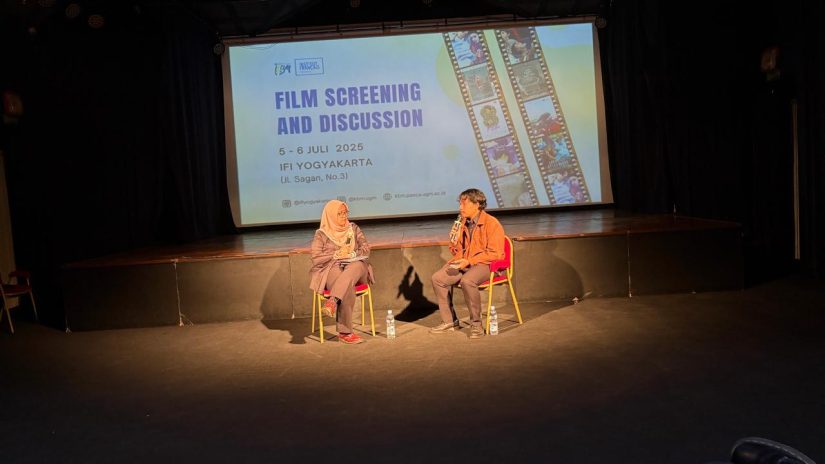
There was something different about the 2025 Community Service Program (PKM) organized by the Media and Cultural Studies (Kajian Budaya dan Media/KBM) program at UGM. In collaboration with IFI Yogyakarta, KBM hosted a film screening and discussion. On the third day of the event, Sunday (July 6th), three short films were screened and discussed: My Clouded Mind, Memoria, and Changing Rooms.
The session was moderated by Gerry Junus, a researcher and film programmer, with Dr. Arifah Arum Chandra H., S.S., M.A. as the main speaker. The discussion, themed “Sexual Violence Targeting the Body and Memory,” drew strong interest from students, film communities, and the general public. Around 35 participants attended the event held at the IFI Yogyakarta Auditorium.
The film My Clouded Mind tells the story of Naura, who breaks off a long-distance relationship after discovering a darker side of her partner—shattering her trust. However, she then becomes a victim of online gender-based violence (OGBV) when intimate photos of her are spread online. Directed by Annisa Adjam, the film portrays Naura’s painful struggle to heal and reclaim her life.
Aziz, one of the attendees, shared that he had experienced something very similar to the characters in the film. He once had someone close to him go through the same trauma and found it difficult to respond. Another attendee, Laili, noted how OGBV is increasingly common, particularly in her surroundings.
Dr. Arifah Arum Chandra emphasized how the notion of space is significant across these films. In My Clouded Mind, the violence unfolds in digital space. The character Galih, Naura’s brother, initially jokes about phenomena like Open BO or revenge porn, normalizing them. But when it affects his sister, he is forced to confront and shift his perspective. Galih must navigate two conflicting roles: as a brother and as a man, each shaped by differing values.
The second film, Memoria, reflects on violence during the Indonesian military invasion of Timor-Leste. It is filled with symbolism. The protagonist Maria’s injury is located on the back of her neck, inflicted by her husband. The wound’s placement suggests it is unseen by the victim herself, requiring someone else to help her heal. In this story, it is her daughter, Flora, who cares for the wound.
The final film, Changing Rooms (international title), is known in French as What Belongs to Cesar, each version offering different interpretive angles. The story shows how locker rooms become a space for toxic masculinity to be reinforced among Cesar and his peers. However, these values begin to crumble when Cesar discovers that his sister is a survivor of sexual violence, prompting him to reject those harmful beliefs.
Ratna Noviani observed a scene where, as the car linked to the crime is lifted, a cat that had been sheltering under it moves beside Cesar’s sister. This symbolizes that spaces marked by sexual violence are not strictly black or white. These traumatic spaces cannot simply be erased—sometimes, they also serve as safe zones for survivors.
Dr. Arum also warned against victim-blaming rhetoric rooted in “should have” language: Naura shouldn’t have gone to the hotel, Maria should have escaped from the soldiers, Cesar’s sister should have refused the ride. These “should haves,” Arum said, only serve to re-victimize survivors and obstruct healing.
The discussion also included reflections on how few men attended—despite the urgent need for men to be involved in such spaces and conversations. Gerry responded that for many men, challenging long-held notions of masculinity can be deeply unsettling—as depicted in Changing Rooms, where Cesar’s world is turned upside down.
The talk acknowledged how memories and trauma of sexual violence do not simply disappear. They linger and often resurface. In fact, some Indonesian films—while attempting to empower—end up retraumatizing victims by reproducing violence through a male gaze. Problematic scenes, shot with excessive audio-visual detail, often alienate rather than empower, and these films still circulate widely. Despite the intent to build empathy, such portrayals can cross ethical boundaries. There are, of course, more responsible and empathetic ways to represent trauma on screen.
The three films screened in this session intentionally avoided sensationalism. While Memoria includes a brief depiction of sexual assault and its aftermath, it is filmed with great empathy. This reflects the importance of the directors’ backgrounds and their teams. Screenings like this are not merely about entertainment—they are about knowledge production, discourse building, and creating safe spaces to talk, listen, and nurture empathy for survivors of sexual violence.
The session ended by questioning the role of the state—which may be present but often fails to act. In Memoria, for example, the military—representing the state—becomes the perpetrator. The discussion also highlighted the state’s denial of victims, such as through public statements by officials like Fadli Zon, Indonesia’s Minister of Culture, who denied the mass violence of 1998. From the New Order era to the cases of Gerwani and Marsinah, victims of violence have been repeatedly stigmatized, their stories erased from official memory.
Contributor: Gerry Junus
